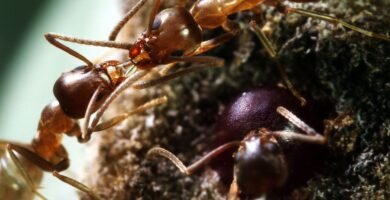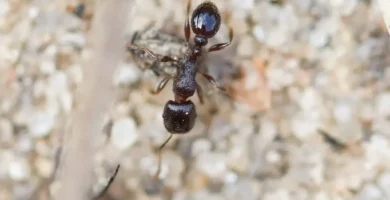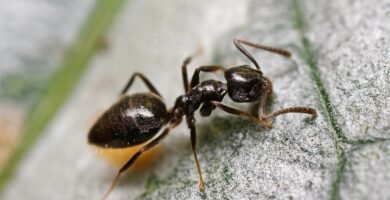
Fire ants, scientifically known as Solenopsis invicta, are a species of stinging ants native to South America. These ants have become a significant pest problem in the United States due to their aggressive nature, painful stings, and rapid spread. Fire ants are typically reddish-brown in color and can range from 1/8 to 1/4 inch in length. Their colonies can grow rapidly, with a single queen capable of laying thousands of eggs per day.
Table of Contents
Why Are Fire Ants a Problem in the United States?
Fire ants pose several problems in the United States. Firstly, their stings can cause severe pain, allergic reactions, and even anaphylaxis in some individuals. Secondly, fire ants are known for their aggressive behavior, especially when their nests are disturbed. They can swarm and attack in large numbers, posing a risk to humans, pets, and livestock. Lastly, fire ants can cause significant damage to electrical equipment, crops, and property, leading to costly repairs and economic losses.
Common Species of Fire Ants in the US
While there are several species of fire ants, the most problematic in the United States are the Red Imported Fire Ants (Solenopsis invicta) and the Southern Fire Ants (Solenopsis xyloni). The Red Imported Fire Ants are the most aggressive and widespread, having established themselves in many southern states. The Southern Fire Ants, while less aggressive, can still cause significant problems in homes and gardens.
Understanding the Behavior and Habitat of Fire Ants
Fire Ants’ Nesting Habits
Fire ants typically build their nests in open, sunny areas such as lawns, fields, and pastures. These nests, or mounds, can reach heights of up to 18 inches and can be quite extensive underground. Fire ants prefer sandy or loamy soil but can adapt to various environments, including urban areas. Their nests are often found near structural foundations, under sidewalks, and around electrical equipment.
Diet and Feeding Patterns
Fire ants are omnivorous and have a diverse diet. They feed on insects, seeds, and plants, but they are also known to scavenge dead animals and food scraps. Their diverse diet allows them to thrive in various environments, contributing to their rapid spread. Fire ants forage in large numbers, and their aggressive nature helps them dominate other ant species and pests in the area.
Seasonal Activity and Movement
Fire ants are most active during warm months, typically from spring to fall. During these seasons, they expand their colonies and forage for food more aggressively. In colder months, their activity decreases, and they remain mostly underground to protect themselves from the cold. However, in warmer climates, fire ants can remain active year-round, posing a constant threat to homeowners and farmers.
Identifying Fire Ant Infestations
Signs of Fire Ant Infestation in Homes
Identifying a fire ant infestation early is crucial for effective pest control. Some common signs include:
- Visible ant trails leading to and from food sources.
- Small piles of dirt or soil indicating the presence of nests.
- Frequent sightings of fire ants, especially in kitchens and near food storage areas.
- Discovery of painful, itchy stings on humans and pets.
Recognizing Fire Ant Mounds
Fire ant mounds are distinctive and can help identify an infestation. These mounds are usually dome-shaped and can range from a few inches to over a foot in height. Unlike other ant species, fire ant mounds do not have a central opening. Instead, fire ants enter and exit the mound through underground tunnels. Disturbing these mounds can cause a swarm of ants to emerge, so it is best to approach them with caution.
Differentiating Between Fire Ants and Other Ant Species
Differentiating fire ants from other ant species is essential for targeted pest control. Fire ants are typically reddish-brown with a darker abdomen. They have a distinct stinger and are more aggressive than most other ant species. Argentine ants, another common pest, are smaller and dark brown to black. Unlike fire ants, Argentine ants do not sting but can invade homes in large numbers, seeking food and water.
The Dangers and Impacts of Fire Ant Infestations
Health Risks Posed by Fire Ants
Fire ants pose significant health risks due to their venomous stings. A single sting can cause intense pain, itching, and swelling. For individuals allergic to fire ant venom, stings can lead to severe reactions, including anaphylaxis, which requires immediate medical attention. Multiple stings can be particularly dangerous, especially for children, the elderly, and pets.
Damage to Property and Infrastructure
Fire ants can cause extensive damage to property and infrastructure. Their nests can undermine foundations, causing structural damage to buildings and sidewalks. Fire ants are also attracted to electrical equipment, where they can cause short circuits and equipment failures. This behavior can lead to costly repairs and disruptions in services.
Impact on Pets and Livestock
Fire ants can pose a serious threat to pets and livestock. Pets that disturb fire ant mounds can be stung multiple times, leading to severe pain and potential allergic reactions. For livestock, fire ant stings can cause weight loss, decreased milk production, and in severe cases, death. Protecting animals from fire ant infestations is essential for their health and well-being.
Professional Pest Control for Fire Ants
Methods Used by Professionals to Exterminate Fire Ants
Professional pest control services employ various methods to exterminate fire ants effectively. These methods include:
- Baiting: Using specially formulated baits that attract fire ants. The ants carry the bait back to the nest, where it is shared with the colony, eventually killing the queen and other ants.
- Chemical Treatments: Applying insecticides directly to fire ant mounds or using broadcast treatments to cover larger areas.
- Integrated Pest Management (IPM): Combining multiple methods, including environmental modifications and biological controls, to manage fire ant populations sustainably.
Benefits of Hiring Pest Control Experts
Hiring professional pest control experts offers several benefits:
- Expertise: Professionals have the knowledge and experience to identify and treat fire ant infestations effectively.
- Safety: Professionals use safe and approved methods to eliminate fire ants, reducing the risk of exposure to harmful chemicals.
- Efficiency: Professional treatments are often more effective and longer-lasting than DIY methods.
- Peace of Mind: Homeowners can rest assured that their fire ant problem is being handled by experts.
Comparing DIY Methods vs. Professional Services
While DIY methods can provide temporary relief, they often fall short of eliminating fire ant colonies completely. DIY treatments may only address visible ants, leaving the queen and the rest of the colony intact. Professional services, on the other hand, use comprehensive approaches that target the entire colony, ensuring more effective and long-lasting results.
Case Study: Effective Fire Ant Control in Homes
Success Stories from Various States
Across the United States, there have been numerous success stories of homeowners effectively managing fire ant infestations with the help of professional pest control services. For example, in Texas, a homeowner faced a severe fire ant infestation that threatened their garden and pets. After hiring a professional pest control service, the infestation was eradicated using a combination of baiting and chemical treatments, restoring peace to the household.
Techniques and Products Used
Successful fire ant control often involves a combination of techniques and products. Baits containing insect growth regulators (IGRs) are commonly used to disrupt the reproductive cycle of fire ants. Insecticides like fipronil and bifenthrin are applied to mounds and surrounding areas to kill ants on contact. Additionally, some pest control services use biological controls, such as introducing predatory insects or pathogens that target fire ants.
Long-Term Solutions for Fire Ant Control
Long-term fire ant control requires ongoing monitoring and preventive measures. Homeowners can work with pest control professionals to develop a customized plan that includes regular inspections, baiting programs, and environmental modifications to reduce fire ant habitats. By taking a proactive approach, homeowners can prevent future infestations and protect their property from fire ants.
Recap of Effective Pest Control for Fire Ants
Effective pest control for fire ants requires a combination of professional treatments, ongoing monitoring, and preventive measures. By understanding fire ant behavior, identifying infestations early, and employing targeted control methods, homeowners can successfully manage and eliminate fire ant problems.
Importance of Professional Pest Control Services
Professional pest control services offer expertise, safety, and efficiency in dealing with fire ant infestations. Their comprehensive approaches ensure more effective and long-lasting results compared to DIY methods, providing homeowners with peace of mind.
Future Outlook on Fire Ant Management in the US
As fire ants continue to pose challenges in the United States, ongoing research and advancements in pest control methods will be crucial for effective management. Collaboration between homeowners, pest control professionals, and researchers will help develop sustainable solutions to mitigate the impact of fire ants and protect communities from their threats.
Other common species of ants in the USA
22 July, 2024

Pest Control for Argentine Ants
22 July, 2024

Pest Control for Pavement Ants
22 July, 2024

Pest Control for Odorous House Ants
19 July, 2024

Pest Control for Carpenter Ants
Frequently Asked Questions about Fire Ants and Pest Control
How to permanently get rid of fire ants?
Permanently getting rid of fire ants involves a strategic combination of professional pest control for fire ants, ongoing inspections, and preventive actions. A certified pest control service typically uses a multi-pronged approach, including baiting systems and chemical treatments specifically designed to target fire ant colonies. Additionally, maintaining regular pest control for fire ants will ensure that any resurgence of colonies is detected early, preventing a future infestation. It’s crucial to follow up with habitat modifications to reduce the likelihood of these pests returning.
What do professionals use to kill fire ants?
Professionals utilize advanced pest control for fire ants, incorporating highly effective baits, chemical treatments, and integrated pest management (IPM) strategies. Baits often include insect growth regulators that prevent the reproduction of the colony, while chemical treatments use active ingredients like fipronil and bifenthrin, which are highly effective in eliminating fire ants quickly. This dual approach ensures that pest control for fire ants targets both the existing colony and future infestations.
What kills fire ants the fastest?
The fastest way to kill fire ants involves using pest control for fire ants with fast-acting insecticides. Chemical treatments with active ingredients such as bifenthrin and fipronil are often used, as they are highly effective when applied directly to the fire ant mounds. Some treatments also include broadcast applications over large areas to target multiple colonies at once, ensuring the swiftest pest control for fire ants possible. Regular monitoring by professionals helps maintain the long-term eradication of these pests.
What do fire ants hate the most?
Fire ants are particularly sensitive to certain natural substances, such as citrus oils, vinegar, and diatomaceous earth. These can act as repellents when used correctly, although they may not be as effective as professional pest control for fire ants. Homeowners often use these natural methods to complement other pest control strategies, creating an environment that is less appealing to fire ants. However, for more severe infestations, it’s recommended to seek professional pest control for fire ants to ensure long-term success.
What is the natural enemy of fire ants?
Fire ants have a few natural enemies that help keep their populations in check. Among them are parasitic flies, such as the phorid fly (Pseudacteon tricuspis), which lays its eggs inside fire ants, eventually killing them. Other predatory ants and certain fungal pathogens can also act as biological controls. Although these natural enemies contribute to managing fire ant populations, they are often not enough to fully eradicate infestations. In such cases, professional pest control for fire ants is recommended to effectively manage and eliminate colonies.
How to get rid of red ants permanently?
Permanently getting rid of red ants requires a comprehensive pest control for fire ants approach, even though the methods for red ants are similar. Professionals usually implement baiting systems and targeted chemical treatments to eliminate the colony, followed by routine inspections and habitat modification. Maintaining pest control for fire ants and similar species ensures that any potential re-infestation is managed swiftly, providing long-term solutions.
Are there natural methods to control fire ants?
Yes, several natural methods can help in controlling fire ants. These include using diatomaceous earth, citrus oils, and vinegar as repellents. Additionally, introducing natural predators like parasitic flies and predatory ants can aid in reducing fire ant populations. However, for a more reliable solution, combining these methods with professional pest control for fire ants is recommended. Natural methods alone may not be sufficient for larger infestations, but they can support a broader pest control strategy.
How do fire ants enter homes?
Fire ants typically enter homes through small cracks and openings in the foundation, walls, or windows. They are often drawn to areas with food, moisture, and warmth, such as kitchens and bathrooms. To prevent entry, it’s important to seal any potential entry points and maintain regular pest control for fire ants. This ensures that your home remains protected against these invasive pests.
Can fire ants cause structural damage to homes?
Yes, fire ants can cause significant structural damage if left unchecked. They often nest in foundations, walls, and even inside electrical equipment, which can lead to electrical shorts or damage to wiring. Their nests can also undermine the integrity of outdoor structures, such as driveways or patios. It is essential to maintain pest control for fire ants to prevent costly repairs and to protect your home’s structure from potential damage caused by these pests.
What precautions should be taken to avoid fire ant infestations?
To avoid fire ant infestations, it’s important to adopt several preventive measures alongside professional pest control for fire ants:
Seal Entry Points: Ensure that cracks, gaps, and holes in the foundation, walls, and windows are sealed to prevent fire ants from entering.
Reduce Food Sources: Keep your kitchen clean, store food in sealed containers, and promptly clean up any crumbs or spills.
Maintain Cleanliness: Regularly remove trash, clean food storage areas, and ensure that outdoor garbage bins are tightly sealed.
Eliminate Moisture: Repair any leaks and manage moisture levels, particularly in basements and other damp areas, to make your home less attractive to fire ants.
By combining these precautions with ongoing pest control for fire ants, homeowners can significantly reduce the likelihood of infestations.
For more information on pest control for other household pests, consult reputable sources such as the Centers for Disease Control and Prevention (CDC) and local pest control professionals.
